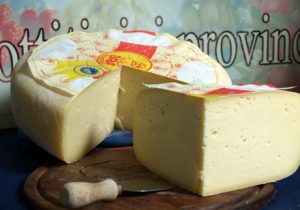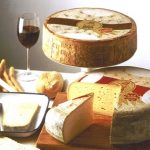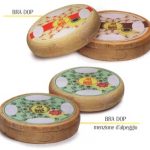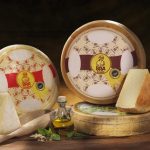
Name
Bra PDO
Seal of quality
Protected Designation of Origin – PDO (EEC Reg 1263 dated 01/07/1996).
Description
Milk of excellent characteristics, processed and seasoned according to techniques of a very old tradition, is the secret of this product’s unique characteristics.
Bra PDO can be produced in different types: Soft and Hard. Both types are of a cylindrical form with flat faces measuring from 30 to 40 cm in diameter and a lateral covering with a slight 5- to 10- cm convex The weight of a whole form varies from 5 to 9 kg . The maturing period must be 45 days for the soft type and 180 days for the hard type.
The hard type, with its thick rind, is dark beige, it is spicy and savoury, above all if left to season for a long time (8-10 months and more), and can also be grated; the soft type, which has a light grey, elastic, smooth and regular rind, has a pleasant fragrance and its taste is less intense.
Bra PDO is produced with cow’s milk, and, when necessary, small additions of sheep’s milk and/or goat’s milk in the total maximum measure of 10%.
For the production of Bra Tenero, the milk is brought to a temperature of 35°C , with an addition of liquid calf cheese-rennet. The cheese-rennet is broken down in two phases: first, with a rotary movement using a Swiss-type of curd knife, and pressing is carried out for fifteen minutes. Salting takes place by pickling (12% of salt) and maturing takes about a month and a half.
“Bra Duro”, on the other hand, is brought to a temperature of 29- 30°C (in coppers), also with the addition of liquid rennet as for the “tenero” type. Dry-salting is carried out for a period of six days with 24-hour intervals. Maturing takes place from six months to a year.
Nutritional characteristics
Follows the nutritional characteristics of Bra Tenero e Bra Duro.
| Unit of measurement | Bra duro | Bra tenero | |
|---|---|---|---|
| protein | g/100g | 30.2 | 30 |
| carbohydrates | g/100g | <1 | <1 |
| of which sugar | g/100g | <1 | <1 |
| fat | g/100g | <32> | <32 |
| of which saturated | g/100g | 20,4 | 22 |
| of which trans | g/100g | 1,7 | 1,9 |
| cholesterol | Mg/100g | 91.3 | 105 |
| calcium | mg/kg | 8000 | 8000 |
| iron | mg/kg | 4 | 4 |
| sodium | mg/kg | 7000 | 7000 |
| Vitamin A | mg/kg | 2,5 | 2,5 |
| Vitamin C | mg/kg | <1 | <1 |
| Energy value | kcal/100g | 374 | 378.4 |
Area of production
Bra cheese is produced throughout the administrative region of the province of Cuneo with milk produced exclusively in the same province, as specified by Decree of the President of the Republic 16 th December 1982 (Official Gazette n. 196 dated 19 th July 1983). The area of maturing includes the entire region of the province of Cuneo and the entire administrative region of Villafranca Piemonte in the province of Turin .
If produced within the region of production in classified places such as mountain communes, the Bra PDO forms, in both varieties, can bear the word “d’Alpeggio“: in this case the background of the paper label is green and bears the word “d’Alpeggio”.
History
Piedmont is among the Italian regions which, more than others, can boast old dairy traditions and its cheeses with protected denomination of origin represent an example of how the art of the shepherds here has been capable of giving life to genuine “pearls” for us to eat.
One of these pearls is Bra cheese, which bears the name of the small town, capital of Roero, situated on the boundary between the Langhe and the plains of Cuneo . Today, not even one form of this cheese is produced in Bra, and even before it came mainly from the villages of the valley and mountains of Cuneo . Nevertheless, the “braidese” tradesmen were the ones who to matured and brought “il nostrale”(home-product cheese) to the Piedmontese markets and, above all, Ligurian markets, where it was greatly appreciated as an exquisite ingredient in the preparation of pesto (sauce made of oil, basil, garlic, pine seeds and cheese).
Today, it is still in great demand in the Genoese region. The favourable climatic conditions and the perfect geographic dislocation of Bra made this town the biggest gathering point for maturing and marketing, done initially on carts drawn by horses. In great demand among the Piedmontese emigrants, this cheese was brought to the Americas, thanks to the fact that it was able to stand long months of sailing, without perishing even at inevitable sudden changes of temperature.
Marketing still regards Piedmont, Liguria, Lombardy, whereas a part of the product is exported.
The two types produced, Bra “tenero” and Bra “duro” – AOC since 1983 – obtained the Protected Denomination of Origin in 1996.
The “Consorzio per la tutela del formaggio Bra” (Association for the protection of Bra cheese) is working to protect and give value to BRA PDO cheese.





